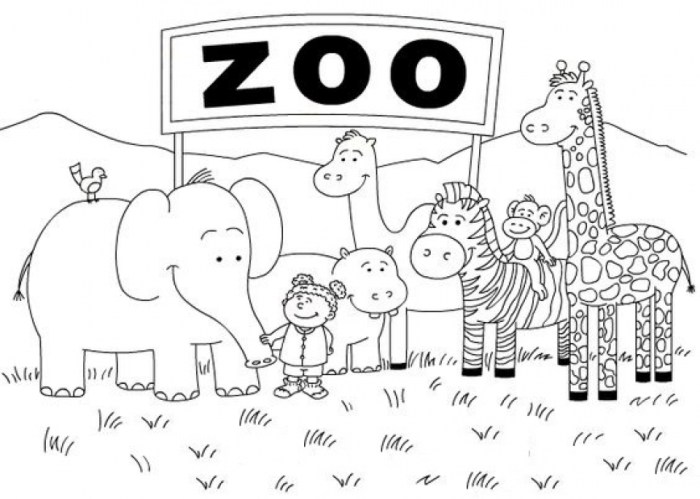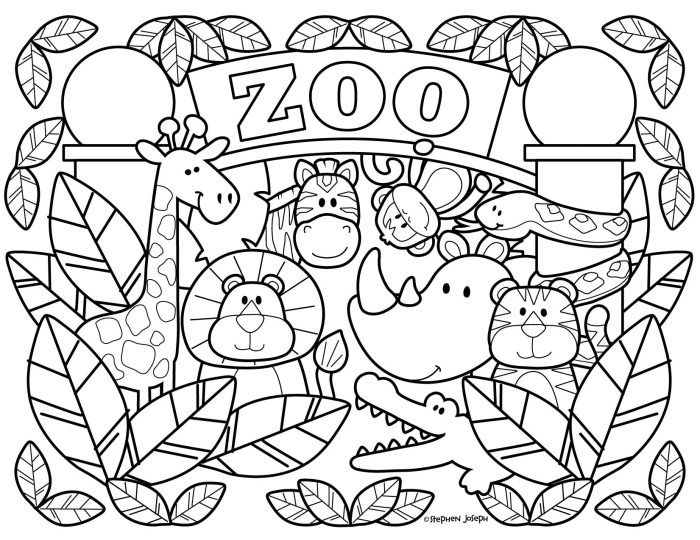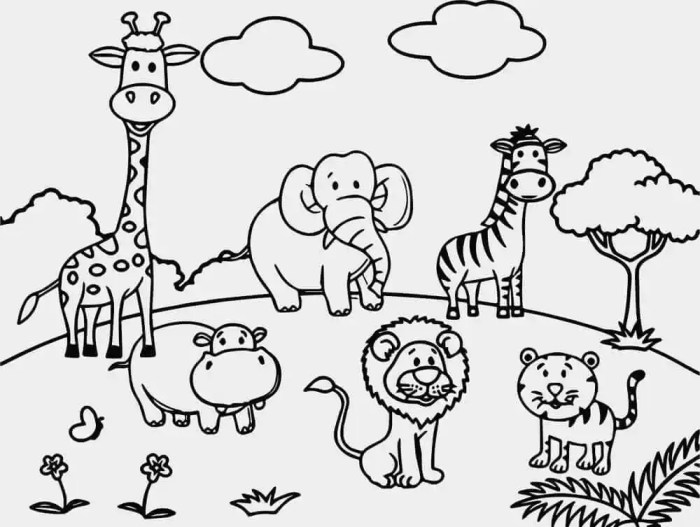Popularity and Trends of Zoo Animal Coloring Pages

Free printable zoo animal coloring pages enjoy widespread popularity, particularly among children but also extending to teenagers and adults. Their enduring appeal stems from a combination of factors, including readily available digital resources, the inherent therapeutic benefits of coloring, and the engaging nature of zoo animals themselves. This popularity is reflected in the vast number of websites offering these pages and the consistent high search volume for related s.
Popularity of Zoo Animal Coloring Pages
The popularity of free printable zoo animal coloring pages is substantial and consistent. While precise figures on downloads are difficult to obtain, the sheer volume of websites offering these resources, coupled with the consistent high search engine rankings for related s like “free printable zoo animal coloring pages,” “lion coloring page,” or “zebra coloring page,” indicates a significant and ongoing demand.
This demand is fueled by parents, teachers, and individuals seeking engaging and educational activities. The accessibility of free printable resources online further enhances their appeal, making them a readily available option for a diverse audience.
Most Popular Zoo Animals Featured
Certain zoo animals consistently appear more frequently in coloring pages than others. Big cats, such as lions, tigers, and leopards, are perennial favorites, likely due to their majestic appearance and inherent appeal. Other popular choices include elephants, giraffes, monkeys, zebras, and pandas. These animals often feature in simplified, cartoonish designs suitable for younger children, as well as more detailed and realistic depictions for older children and adults.
The popularity of specific animals can also fluctuate based on current events or media trends; for instance, a popular movie featuring a particular animal might lead to a surge in demand for coloring pages featuring that animal.
Design Trends Across Age Groups
Coloring page designs vary significantly across different age groups. Pages aimed at young children (typically preschool to early elementary school) often feature simplified Artikels, bold colors, and large, easily colored areas. Designs may incorporate cartoonish features or bright, primary colors. Teenagers and adults, on the other hand, often prefer more intricate and detailed designs. These may include realistic depictions of animals, complex patterns, and opportunities for creative shading and blending.
Adult coloring books, a significant market segment in recent years, frequently feature highly detailed zoo animal designs intended to provide a calming and meditative experience. The trend leans toward more sophisticated and artistic representations as the target age increases.
Factors Contributing to Popularity
Several factors contribute to the enduring popularity of zoo animal coloring pages. The accessibility of free online resources is a key factor, allowing widespread access regardless of socioeconomic background. The therapeutic benefits of coloring, such as stress reduction and improved focus, are also increasingly recognized, further driving demand, particularly among adults. The inherent appeal of zoo animals, their diversity, and their captivating characteristics provide endless creative possibilities.
Furthermore, coloring pages offer a screen-free activity, providing a welcome alternative to digital entertainment and promoting creativity and fine motor skill development, particularly for children. The educational aspect, subtly teaching about different animals and their features, also adds to their appeal.
Design and Artistic Aspects: Free Printable Zoo Animal Coloring Pages

Zoo animal coloring pages cater to a diverse audience, from toddlers to adults, necessitating a range of artistic styles and design elements to appeal to varying preferences and skill levels. The visual appeal significantly impacts a coloring page’s popularity and its ability to engage the user. Careful consideration of artistic style, color palettes, and design elements is crucial for creating effective and engaging coloring pages.
Looking for free printable zoo animal coloring pages? You’re in luck! There’s a ton of options available online, and if you need some inspiration, check out this great resource for coloring sheets zoo animals to get your creative juices flowing. Then, you can easily find similar free printable zoo animal coloring pages to print at home and start coloring!
The artistic styles employed in zoo animal coloring pages span a broad spectrum, each offering unique advantages and targeting different user demographics. Common styles include realistic representations aiming for anatomical accuracy, cartoonish styles prioritizing cuteness and simplification, and simplified designs focusing on basic shapes and Artikels suitable for younger children. The choice of style directly influences the level of detail, complexity, and overall aesthetic of the coloring page.
Artistic Styles in Zoo Animal Coloring Pages
Three main artistic styles dominate the zoo animal coloring page landscape: realistic, cartoonish, and simplified. Realistic designs often feature intricate details, accurate anatomical proportions, and lifelike textures. Cartoonish styles employ exaggerated features, playful expressions, and often incorporate anthropomorphic elements. Simplified designs use basic shapes and minimal details, making them accessible to younger children with limited fine motor skills.
The selection of style heavily influences the overall visual impact and target audience.
Color Palettes in Zoo Animal Coloring Pages, Free printable zoo animal coloring pages
The color palettes used in zoo animal coloring pages are equally diverse, reflecting the wide variety of animals depicted and the intended aesthetic. Earthy tones are frequently used for realistic depictions, accurately reflecting the natural colors of animals in their habitats. Bright, vibrant colors are common in cartoonish designs, emphasizing playfulness and visual appeal. Pastel shades are often used to create a softer, gentler aesthetic, suitable for younger children or those preferring a more calming color scheme.
The strategic use of color enhances the visual appeal and contributes to the overall mood of the coloring page.
Comparison of Design Elements Across Different Styles
The table below compares key design elements across the three primary artistic styles. Note that these are general observations and individual designs may deviate from these norms.
| Design Element | Realistic Style | Cartoonish Style | Simplified Style |
|---|---|---|---|
| Line Thickness | Variable, often thin and detailed | Bold, consistent, often thick Artikels | Thick, simple Artikels |
| Detail Level | High, including intricate textures and shading | Moderate, focusing on key features and expressions | Low, minimal details, basic shapes |
| Use of Shading | Extensive use of shading to create depth and volume | Minimal shading or use of simple flat shading | Little to no shading |
Categorization of Design Styles
The diverse styles can be further categorized into sub-styles. For instance, within the realistic style, one might find photorealistic designs that mimic photographic images or more painterly styles that emphasize artistic interpretation. Similarly, cartoonish styles range from cute and cuddly to more expressive and comical designs. Simplified styles may be further categorized by the complexity of the shapes used, ranging from very basic geometric shapes to more complex but still simplified representations of animals.
Educational Value and Benefits

Zoo animal coloring pages offer a surprisingly rich educational experience for children, extending far beyond simple entertainment. They provide a fun and engaging way to learn about the animal kingdom, fostering cognitive development and crucial skills. The act of coloring itself contributes to fine motor skill development, while the subject matter encourages learning about diverse animal species and their environments.Coloring pages featuring zoo animals can significantly enhance a child’s creativity and fine motor skills.
The act of choosing colors, coordinating shading, and controlling the movement of crayons or colored pencils strengthens hand-eye coordination, improves dexterity, and refines grip strength. This is particularly important for pre-school and early elementary school children whose fine motor skills are still developing. The creative process involved in coloring also allows children to express their individuality and explore their imagination, leading to improved self-expression and confidence.
Enhancing Creativity and Fine Motor Skills
Children can develop their creative expression through imaginative color choices and unique interpretations of the animals depicted. For example, a child might choose vibrant, unconventional colors for a lion’s mane, expressing their own artistic vision and fostering a sense of ownership over their creation. The detailed nature of many zoo animal coloring pages, often featuring intricate patterns on animal fur or feathers, further challenges and refines fine motor skills.
The precise movements required for coloring within lines and adding details improves hand-eye coordination and control. Repeated practice with coloring pages can lead to noticeable improvements in a child’s dexterity and precision.
Integration into Educational Activities
Zoo animal coloring pages can be readily integrated into various educational activities. For instance, after a lesson on animal habitats, children could color pages depicting animals in their natural environments, reinforcing their understanding of the relationship between animals and their surroundings. Similarly, following a lesson on animal diets, children can color pictures of animals alongside the foods they consume, creating a visual representation of the food chain.
This hands-on approach can make abstract concepts more concrete and memorable for young learners. A teacher could also use coloring pages as a reward system or a quiet activity during downtime.
Learning About Animal Habitats and Characteristics
Coloring pages featuring zoo animals can effectively contribute to learning about animal habitats and characteristics. For example, a coloring page of a polar bear in its arctic habitat reinforces the concept of adaptation to cold climates. Similarly, a page showing a giraffe in the African savanna helps children associate the animal with its specific environment. The visual representation of animal features, such as the stripes of a tiger or the spots of a cheetah, aids in memorization and recognition.
This visual learning approach is highly effective for young children, who often learn best through visual aids. Furthermore, teachers can incorporate discussions about animal conservation and endangered species, using the coloring pages as a springboard for deeper learning.
Accessibility and Availability
Free printable zoo animal coloring pages are readily accessible through a variety of online platforms, catering to a diverse range of users with varying technological capabilities and preferences. Their widespread availability reflects the enduring popularity of coloring activities as a form of entertainment and education for children and adults alike. The ease of access to these resources contributes significantly to their continued appeal.The internet provides a vast repository of these coloring pages, distributed across numerous websites and platforms.
These resources differ in their features, functionality, and the overall user experience they provide. Understanding these differences is crucial for users seeking high-quality and user-friendly options.
Online Platforms Offering Free Printable Zoo Animal Coloring Pages
Many websites specialize in offering free printable coloring pages, with a significant portion dedicated to zoo animals. These range from dedicated coloring page websites to broader educational resource sites and even individual artist blogs. Popular platforms include general search engines like Google and Bing, which index countless pages featuring these resources. Additionally, Pinterest acts as a visual search engine, allowing users to discover images through visual similarity.
Specific websites focused on printable activities often curate collections of zoo animal coloring pages, offering a more focused and organized search experience. Finally, some educational websites integrate coloring pages as part of their broader curriculum resources.
Comparison of Website Features and Functionalities
Websites offering free printable zoo animal coloring pages vary significantly in their features. Some websites offer a simple image download, while others provide additional features such as different coloring page styles (realistic, cartoonish, etc.), difficulty levels, themed collections (e.g., big cats, African animals), and the option to filter by animal type. Some sites may incorporate interactive elements, such as online coloring tools, though the core functionality remains the ability to download and print the pages.
Website design also plays a crucial role; user-friendly navigation, clear labeling, and easy-to-find download buttons are essential for a positive user experience. Websites with robust search functionalities, allowing users to quickly locate specific animal coloring pages, are highly advantageous. The presence of a preview option before downloading allows users to assess the quality and suitability of the coloring page before committing to the download.
Commonly Used Formats for Printable Coloring Pages
The most common formats for printable zoo animal coloring pages are PDF (Portable Document Format) and JPG (JPEG, Joint Photographic Experts Group). PDFs generally maintain higher image quality and preserve formatting across different devices and printers. They are often preferred for their ability to preserve the original layout and prevent image distortion. JPGs, while slightly lower in quality, are widely compatible and offer smaller file sizes, leading to faster downloads and easier sharing.
The choice between PDF and JPG often depends on the specific needs of the user and the capabilities of their printing equipment. Other formats, such as PNG (Portable Network Graphics), are less frequently used for coloring pages but may be encountered occasionally.
Design of a User Interface for a Website Dedicated to Free Printable Zoo Animal Coloring Pages
A user-friendly website dedicated to free printable zoo animal coloring pages should feature a clean and intuitive design. The homepage could showcase a selection of popular coloring pages with thumbnails, each linked to a dedicated page for downloading. A search bar would allow users to quickly find specific animals. Categorization by animal type (e.g., mammals, birds, reptiles) and difficulty level (easy, medium, hard) would enhance navigation.
Each coloring page should have a preview, a clear download button, and information about the file format (PDF or JPG). A simple, uncluttered design, using bright, child-friendly colors, would enhance the overall user experience. The inclusion of a brief description of each animal on its respective coloring page would add educational value.












